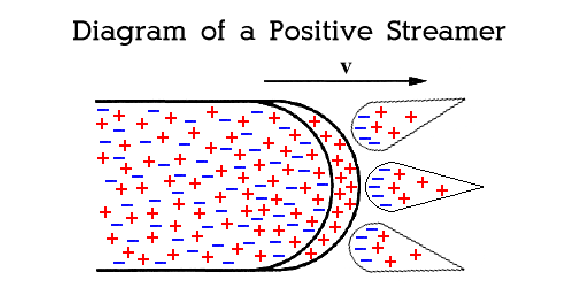 |
The streamer which develops from the positive ion region has a net positive charge in its tip and is referred to as a positive streamer. A schematic illustration of a positive streamer is shown in Figure 2.10. Multiple electron avalanches are produced by free electrons in the high electric field region ahead of the streamer tip. The avalanches fill in the positive tip, but also leave behind positive ions. These positive ions become the new streamer tip and the avalanche process can continue.
 |
The avalanche process and resulting streamer motion will be continuous provided there are a sufficient number of free electrons ahead of the streamer tip and a sufficiently large external electric field. At tropospheric altitudes, the free electrons are generated by photoionization. At the altitudes of sprites within the mesosphere, enough free electrons may already be present for stable streamer propagation (Raizer et al., 1998).
The minimum electric field, ![]() , required for positive streamer
propagation in air at standard temperature and pressure (STP) has been
measured to be between 400 and 440 kV/m
(Phelps, 1974; Allen and Ghaffar, 1995; Loeb and Meek, 1940), corresponding to an
, required for positive streamer
propagation in air at standard temperature and pressure (STP) has been
measured to be between 400 and 440 kV/m
(Phelps, 1974; Allen and Ghaffar, 1995; Loeb and Meek, 1940), corresponding to an
![]() of 15-16 Td. This is
of 15-16 Td. This is ![]() 8 times less than the
breakdown threshold,
8 times less than the
breakdown threshold, ![]() , of
, of ![]() 123 Td (see
Section 2.2.3).
123 Td (see
Section 2.2.3).
Measurements of positive streamer propagation by
Griffiths and Phelps (1976) show that ![]() is not a constant, but
actually diminishes with decreasing air density. Their measurements
indicate that
is not a constant, but
actually diminishes with decreasing air density. Their measurements
indicate that ![]() decreases from
decreases from ![]() 15 Td at 1000 mb
(
15 Td at 1000 mb
(![]() 0 km MSL) to
0 km MSL) to ![]() 9 Td at 300 mb (
9 Td at 300 mb (![]() 11 km MSL) and a
constant temperature of 25
11 km MSL) and a
constant temperature of 25![]() C. Raizer et al. (1998) noted
that at higher altitudes and lower atmospheric densities, the
attachment of electrons to oxygen loses importance due to the lower
collision frequencies and the
C. Raizer et al. (1998) noted
that at higher altitudes and lower atmospheric densities, the
attachment of electrons to oxygen loses importance due to the lower
collision frequencies and the ![]() value should approach that for
molecular nitrogen (6 Td), a non-electronegative
(non-electron-attaching) gas. They calculated that for a charge
moment change of 350 C
value should approach that for
molecular nitrogen (6 Td), a non-electronegative
(non-electron-attaching) gas. They calculated that for a charge
moment change of 350 C![]() km, a positive streamer would propagate
from an altitude of 80 km MSL down to 48 km MSL, where it would
terminate. Triangulated measurements of sprites show that they often
extend down to 50 km or lower (Sentman et al., 1995) while the charge
moment changes of sprite-producing discharges have been measured to be
km, a positive streamer would propagate
from an altitude of 80 km MSL down to 48 km MSL, where it would
terminate. Triangulated measurements of sprites show that they often
extend down to 50 km or lower (Sentman et al., 1995) while the charge
moment changes of sprite-producing discharges have been measured to be
![]() 300 C
300 C![]() km (Huang et al., 1999; Cummer and Stanley, 1999). A
charge moment analysis of several sprite-producing discharges is
presented in Section 5.3.
km (Huang et al., 1999; Cummer and Stanley, 1999). A
charge moment analysis of several sprite-producing discharges is
presented in Section 5.3.
Raizer et al. (1998) calculated that the velocity of the downward
positive streamer propagation would maximize at
![]() 1.2
1.2![]() 10
10![]() m/s about 4 ms after it was initiated at an
altitude of 80 km under the influence of a 350 C
m/s about 4 ms after it was initiated at an
altitude of 80 km under the influence of a 350 C![]() km charge
moment change. Actual measurements of maximum average positive
streamer velocities in sprites will be presented in
Chapter 5 and compared with theoretical predictions.
km charge
moment change. Actual measurements of maximum average positive
streamer velocities in sprites will be presented in
Chapter 5 and compared with theoretical predictions.
A schematic diagram of a negative streamer will differ from that of
the positive streamer in that the tip of negative streamer will be
negatively charged and the electron avalanches will point outward from
the tip. As was discussed by Pasko et al. (2000), the minimum
electric field, ![]() , for negative streamer propagation is two to
three times higher than for positive streamers and thus
, for negative streamer propagation is two to
three times higher than for positive streamers and thus ![]() CG sprites
will tend to be less vertically extensive than
CG sprites
will tend to be less vertically extensive than ![]() CG sprites.
CG sprites.